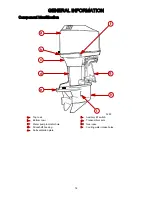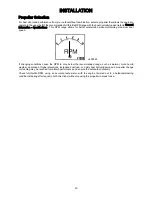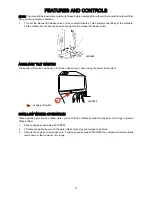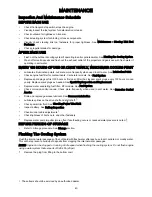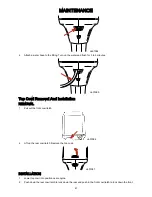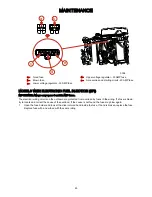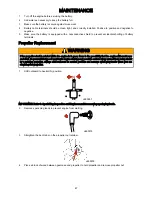
OPERATION
32
Pre-Starting Check List
•
Operator knows safe navigation, boating, and operating procedures.
•
An approved personal flotation device of suitable size for each person aboard and readily accessible (it is
the law).
•
A ring type life buoy or buoyant cushion designed to be thrown to a person in the water.
•
Know the boats maximum load capacity. Look at the boat capacity plate.
•
Fuel supply OK.
•
Oil supply (oil injection) OK.
•
Arrange passengers and load in the boat so the weight is distributed evenly and everyone is seated in a
proper seat.
•
Tell someone where you are going and when you expect to return.
•
It is illegal to operate a boat while under the influence of alcohol or drugs.
•
Know the waters and area you will be boating; tides, currents, sand bars, rocks, and other hazards.
•
Make inspection checks listed in Maintenance - Inspection and Maintenance Schedule.
Operating In Freezing Temperatures
When using your outboard or having your outboard moored in freezing or near freezing temperatures, keep the
outboard tilted down at all times so the gearcase is submerged. This prevents trapped water in gearcase from
freezing and causing possible damage to the water pump and other components.
If there is a chance of ice forming on the water, the outboard should be removed and drained completely of water.
If ice should form at the water level inside the outboard driveshaft housing, it will block water flow to the engine
causing possible damage.
Operating In Salt Water Or Polluted Water
We recommend that you flush the internal water passages of your outboard with fresh water after each use in salt
or polluted water. This will prevent a buildup of deposits from clogging the water passages. Refer to Maintenance
- Flushing The Cooling System.
If you keep your boat moored in the water, always tilt the outboard so the gearcase is completely out of water
(except in freezing temperatures) when not in use.
Wash the outboard exterior and flush out the exhaust outlet of the propeller and gearcase with fresh water after
each use. Each month, spray Mercury Precision or Quicksilver Corrosion Guard on external metal surfaces. Do
not spray on corrosion control anodes as this will reduce the effectiveness of the anodes.
Operating at High Elevations
ENGINES WITH CARBURETORS
IMPORTANT: To prevent serious damage to the engine caused by a lean fuel mixture, DO NOT operate your
outboard (if the jets were changed for high elevation) at a lower elevation unless the jets are changed again to
correspond to the new elevation.
Operating your outboard at an elevation higher than 750 m (2500 ft.) above sea level may require a carburetor jet
change and/or different pitch propeller. Consult your dealer. This will reduce the normal performance loss
experienced as a result of reduced oxygen in the air causing an overly rich fuel mixture.
ENGINES WITH ELECTRONIC FUEL INJECTION (EFI)
Your engine automatically compensates for high elevation changes. A propeller with a different pitch may be
required to help reduce the normal performance loss experienced as a result of reduced oxygen in the air. Consult
your dealer.

